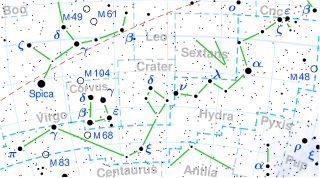V Hydrae
| Observation data EpochJ2000EquinoxJ2000 | |
|---|---|
| Constellation | Hydra |
| Right ascension | 10h51m37.25661s[1] |
| Declination | −21° 15′ 00.3245″[1] |
| Apparent magnitude(V) | 6.0 - 12.3[2] |
| Characteristics | |
| Spectral type | C6,3e-C7,5e(N6e)[3] |
| B−Vcolor index | +5.43[4] |
| Variable type | SRa[3] |
| Astrometry | |
| Radial velocity(Rv) | −14.80[5]km/s |
| Proper motion(μ) | RA:−11.02 ± 1.14[1]mas/yr Dec.:2.29 ± 1.16[1]mas/yr |
| Parallax(π) | 1.44 ± 1.41mas[1] |
| Distance | approx. 2,000ly (approx. 700pc) |
| Absolute magnitude(MV) | −3.5 to +1.8[6] |
| Orbit[7] | |
| Period(P) | 8.5yr |
| Eccentricity(e) | ≥0.6 |
| Details | |
| A | |
| Mass | 1.0[8]M☉ |
| Radius | 420[9]–430[7]R☉ |
| Luminosity | 7,850[8]L☉ |
| Surface gravity(logg) | −0.5[8]cgs |
| Temperature | 2,650[8]K |
| Rotational velocity(vsini) | 11 - 14[8]km/s |
| B | |
| Mass | <1[7]M☉ |
| Other designations | |
| Database references | |
| SIMBAD | data |
V Hydrae(V Hya) is acarbon starin theconstellationHydra.To date perhaps uniquely in our galaxy it has plasma ejections/eruptions on a grand scale every 8.5 years caused by its near, unseen companion in an 8.5 year orbit, inferred by its ultraviolet excess and periastron passage likely through the outer parts of the star itself.
Variability[edit]

V Hydrae is asemiregular variable starof type SRa, sometimes considered to be aMira variable.It pulsates with a period of 530 days and a brightness range of 1-2 magnitudes, but also shows deep fades at intervals of about 6,160 days when it may drop below magnitude 12.[2][11]
Evolutionary stage[edit]
V Hydrae is a latecarbon star,anasymptotic giant branch(AGB) star that hasdredged upsufficient material from its interior to have more carbon in its atmosphere than oxygen. The rate of mass loss from V Hydrae indicates that it is almost at the end of the AGB stage and about to lose its atmosphere completely and form a planetary nebula. It is sometimes considered to be a post-AGB object.[12]
Companions[edit]
V Hydrae has a visible binary companion 46 "distant. It is a magnitude 11.5 K0 giant.[6]
V Hydrae also has an unseen companion inferred by its ultraviolet excess.[13][7]It has been suggested that the steep drops in brightness every 17 years or so are caused by obscuration by a cloud associated with the companion passing in front of the giant star.[13]
Bullets[edit]

V Hydrae has high-speed outflows of material collimated into jets, and also a disk of material around the star. Since the star itself is considered to be at the end of theAsymptotic Giant Branch(AGB) phase of evolution and starting to generate aplanetary nebula,the mechanism for the ejection of this material can give key insights to the formation ofplanetary nebulae.The ejections have been modelled asbulletsof material fired out each time the compact companion passes close to the extended giant star during a highly eccentric orbit. The bullets are ejected in opposite directions in different orbits due to a flip-flop of the ejection mechanism.[7]Microwave spectra of rotational transitions ofcarbon monoxideshow that portions of the envelope, probably the jets, are moving away from the star at 200 km/sec. This is far faster than the ~15 km/sec stellar wind that is typically seen around AGB stars.[14]
References[edit]
- ^abcdeVan Leeuwen, F. (2007). "Validation of the new Hipparcos reduction".Astronomy and Astrophysics.474(2): 653–664.arXiv:0708.1752.Bibcode:2007A&A...474..653V.doi:10.1051/0004-6361:20078357.S2CID18759600.
- ^abWatson, Christopher (4 January 2010)."V Hydrae".The International Variable Star Index.American Association of Variable Star Observers.Retrieved2016-10-12.
- ^abSamus, N. N.; Durlevich, O. V.; et al. (2009). "VizieR Online Data Catalog: General Catalogue of Variable Stars (Samus+ 2007-2013)".VizieR On-line Data Catalog: B/GCVS. Originally Published in: 2009yCat....102025S.1.Bibcode:2009yCat....102025S.
- ^Ducati, J. R. (2002). "VizieR Online Data Catalog: Catalogue of Stellar Photometry in Johnson's 11-color system".CDS/ADC Collection of Electronic Catalogues.2237.Bibcode:2002yCat.2237....0D.
- ^Gontcharov, G. A. (2006). "Pulkovo Compilation of Radial Velocities for 35 495 Hipparcos stars in a common system".Astronomy Letters.32(11): 759–771.arXiv:1606.08053.Bibcode:2006AstL...32..759G.doi:10.1134/S1063773706110065.S2CID119231169.
- ^abGordon, Courtney P. (1968)."The Absolute Magnitudes of Carbon Stars".Publications of the Astronomical Society of the Pacific.80(476): 597.Bibcode:1968PASP...80..597G.doi:10.1086/128694.
- ^abcdeSahai, R.; Scibelli, S.; Morris, M. R. (2016)."High-speed Bullet Ejections during the AGB-to-Planetary Nebula Transition: HST Observations of the Carbon Star, V Hydrae".The Astrophysical Journal.827(2): 92.arXiv:1605.06728.Bibcode:2016ApJ...827...92S.doi:10.3847/0004-637X/827/2/92.S2CID119209118.
- ^abcdeZhao-Geisler, R.; Quirrenbach, A.; Köhler, R.; Lopez, B. (2012). "Dust and molecular shells in asymptotic giant branch stars".Astronomy & Astrophysics.545:A56.arXiv:1207.3767.Bibcode:2012A&A...545A..56Z.doi:10.1051/0004-6361/201118150.S2CID53992211.
- ^Luttermoser, Donald G.; Brown, Alexander (1992). "A VLA 3.6 centimeter survey of N-type carbon stars".Astrophysical Journal.384:634.Bibcode:1992ApJ...384..634L.doi:10.1086/170905.
- ^"Download Data".aavso.org.AAVSO.Retrieved1 October2021.
- ^Olivier, Enrico A.; Whitelock, Patricia; Marang, Fred (2001). "Dust-enshrouded asymptotic giant branch stars in the solar neighbourhood".Monthly Notices of the Royal Astronomical Society.326(2): 490.arXiv:astro-ph/0103294.Bibcode:2001MNRAS.326..490O.doi:10.1046/j.1365-8711.2001.04511.x.S2CID15509666.
- ^Knapp, G. R.; Crosas, M.; Young, K.; Ivezić, Željko (2000). "Atomic Carbon in the Envelopes of Carbon-rich Post–Asymptotic Giant Branch Stars".The Astrophysical Journal.534(1): 324–334.arXiv:astro-ph/9912496.Bibcode:2000ApJ...534..324K.doi:10.1086/308731.S2CID2963393.
- ^abSahai, R.; Findeisen, K.; Gil De Paz, A.; Sánchez Contreras, C. (2008)."Binarity in Cool Asymptotic Giant Branch Stars: A GALEX Search for Ultraviolet Excesses"(PDF).The Astrophysical Journal.689(2): 1274–1278.arXiv:0807.1944.Bibcode:2008ApJ...689.1274S.doi:10.1086/592559.S2CID12437723.
- ^Knapp, G.R.; Jorissen, A.; Young, K. (October 1997)."A 200 km/sec Molecular Wind in the Peculiar Carbon Star V Hya".Astronomy and Astrophysics.326:318–328.Bibcode:1997A&A...326..318K.Retrieved16 November2020.

